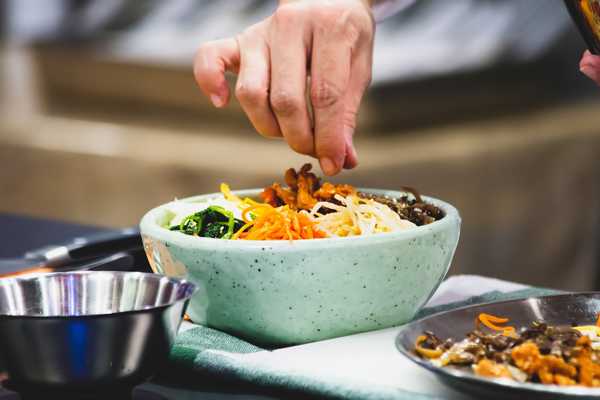The best local dishes in Goseong are some of the delights you can try throughout the county’s charming streets and hillside communities. While most people come to this coastal destination for its sprawling white-sand beaches and historic coastal pavilions, Goseong is also a great place to sample some of the most unique dishes in South Korea.
When it’s time for a break between sightseeing, don’t miss your chance to explore Goseong’s vibrant restaurants and markets, where you’ll discover a wealth of traditional Korean flavours. From top-notch BBQ dishes and wintertime stews to spicy street snacks, appreciating the culinary side of South Korea is made easy when you travel to Goseong.
- 1
Galbi (grilled ribs)
A Korean BBQ classic served in leafy vegetables

- Yemek
Galbi is one of the most popular Korean grilled dishes. Diners are usually served with platters of raw meat, which they cook on a tabletop grill. Complemented with a wonderfully sweet and savoury marinade made from soy sauce, garlic, and sugar, this simple but delicious dish is a staple of many Korean BBQ restaurants.
Beef short ribs are commonly used, as the meat remains juicy and tender when grilled over smoky charcoal. Once ready, use leafy vegetables to wrap the cooked meat with soybean paste, kimchi, and sliced green peppers.
- 2
Bibimbap (Korean rice bowl)
White rice topped with fried egg, seasoned vegetables, and spicy meat

- Yemek
Bibimbap might only date back about 100 years or so, but it has become a quintessential South Korean dish. It’s a bowl of white rice topped with sauteed and seasoned vegetables – like cucumber, mushrooms, and bellflower root – as well as sliced beef.
Some restaurants serve bibimbap with chicken or seafood. Gochujang – a sweet and spicy condiment – gives the dish an excellent flavour. Make sure to mix all the elements before taking a bite.
- 3
Bulgogi (Korean BBQ)
Barbecued and marinated meat

- Yemek
Bulgogi is an iconic Korean dish found in homes and restaurants across the country. Thin slices of marinated beef or pork are grilled on a hot barbecue or stove-top griddle. Most Goseong restaurants use high-quality cuts such as sirloin, tenderloin, or marbled ribeye, so make sure to give it a try during your visit.
When travelling through South Korea, you’ll most likely come across bulgogi marinated in soy sauce, sugar, sesame and garlic. However, there are also common variations that use gochujang (spicy sauce) and chilli powder as an extra burst of heat. Served alongside kimchi and steamed rice, this traditional dish is a must-try during any trip to Goseong.
- 4
Japchae (stir-fried glass noodles)
A former royal dish made with glass noodles

- Yemek
Japchae is often the go-to meal for people who love noodles. This dish comprises glass noodles (made with sweet potato starch), mushrooms, carrots, onions, and spinach. There’s also a good chance you'll come across versions that include meat, usually beef and pork.
Japchae was only available to high-ranking officials during the Joseon Dynasty. Today, you can find it in many family and community celebrations across the country. Plus, you’re certain to come across this much-loved Korean dish at many restaurants in Goseong and beyond.
- 5
Tteokbokki (spicy rice cakes)
Taste this cherished spicy Korean street food

- Yemek
Tteokbokki (stir-fried rice cakes) is one of the most common street foods in South Korea. Great for those who love a bit of spice, this chewy treat is essentially Korean rice cakes cooked in sweet-spicy gochujang sauce.
In Goseong, tteokbokki uses garaetteok – a long cylindrical rice cake that's chopped into bite-sized pieces. You can easily find this snack at many street vendors, local markets, and restaurants across Goseong.
- 6
Sundubu-jjigae (spicy soft tofu stew)
Spicy wintertime stew

- Yemek
Sundubu-jjigae is a tasty stew or soup that’s often enjoyed as a wintertime pick-me-up. This dish packs a punch with freshly curdled soft tofu, an assortment of fresh vegetables, and spicy gochujang paste.
While sundubu-jjigae is traditionally a vegetarian stew, it’s quite common to come across restaurants adding beef or pork to the dish. Some venues also drop a raw egg into the boiling soup before serving.
- 7
Gamja-tang (pork bone soup)
Cosy pork and potato soup

- Yemek
Gamja-tang is an adored Korean soup with an incredibly rich flavour. It’s made by boiling pork neck bones, potatoes, ginger, soybean paste, perilla leaves, dried shiitake mushrooms, onion, and dried red pepper for several hours.
While gamja-tang is believed to have originated in Jeolla, Koreans who moved to Seoul in the early 20th century helped spread the dish to the country’s far-flung regions. Nowadays, you shouldn’t have a problem finding gamja-tang in Goseong or any of its nearby communities.
- 8
Samgyeopsal (grilled pork belly)
Enjoy grilled pork with spicy dipping sauce

- Yemek
Samgyeopsal represents the social side of Korean cuisine, with this straightforward dish available at most BBQ restaurants. It’s best enjoyed with a group of friends – take fresh cuts of pork belly and grill them on a hot pan or charcoal grill.
Pair your samgyeopsal with lettuce or perilla leaves and traditional condiments like ssamjang (spicy dipping sauce). You can opt for a bowl of rice or naengmyeon (cold noodles) if you prefer a filling meal.
- 9
Gimbap (rice rolls)
Find out what makes Korean-style sushi so special

- Yemek
Gimbap might look similar to sushi, but it has a few crucial differences that make it well worth sampling in Goseong. Although vinegar is used to season the Japanese version, gimbap swaps this out for sesame oil, giving the Korean rendition a distinctly sweet flavour.
You can also find gimbap made with either white, brown, or black rice. Seafood like tuna and squid is often added to the rice, but it’s also easy to find vegetarian or vegan options. Cheese, kimchi, and cucumber are also commonplace fillings.
- 10
Jajangmyeon (noodles with black bean sauce)
Chinese-inspired noodle dish

- Yemek
Jajangmyeon was brought to Korea by Chinese immigrants in the early 20th century. It’s believed that an Incheon restaurant started serving up this dish made from noodles, diced pork and black bean sauce. Today, it’s a popular low-cost meal served in many households and restaurants.
Handmade noodles are coated in a thick Korean-style black bean sauce called jajang. Pork is the most common ingredient, but you can also enjoy jajangmyeon with chicken, beef, and seafood. Fresh veggies like onion, green cabbage, and potato complete the dish.



















